Wearing Your Sling:
Play Movie:
 Windows Media Windows Media
 Real Video Real Video
All sling wearing starts the same, no
matter what hold you are going to do.
Start by folding your sling in half.


Put your arm through the opening on the side away from the open
edges.
Slide the pouch over your head down onto your shoulder. The open edges
should be next to your neck, and it should open on the top. The seam
should be in front of you. For the tummy to tummy, cradle and kangaroo
carry, position the pouch seam across the center of your body. This
seam provides the deepest part of the pouch and is where the bulk of
your baby's body will always be. For the hip and back carry, this seam
will be along the side of your body.

Newborn, Cradle Position:
Play Movie:
 Windows Media Windows Media
 Real Video Real Video
Position the pouch so that the bottom of the seam is near your belly
button. Hold your baby with your one arm and open the pouch with your
other hand. Place your baby in the pouch in a "sitting" position,
rather than a "laying" position so that your baby's bottom rests on
the inner seam near or above your naval and your baby's head is high
on your chest. This is a snug position for your little one. Remember
to keep a portion of the sling between you and the baby but most of it
can be in front of the baby. The front of the sling can be pulled up
to help support the baby's head if they don't have head control yet,
or if they fall asleep.
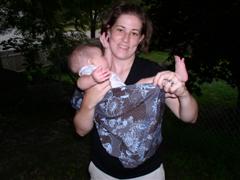 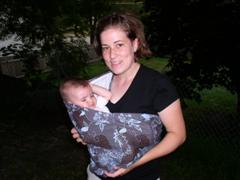
Kangaroo Carry:
Play Movie:
 Windows Media Windows Media
 Real Video Real Video
As you become comfortable with your Pouch and as your baby grows, you
may prefer other positions such as sitting cross legged. The seam of
the pouch should be positioned across the center of your body. Hold
your baby in front of you with their legs crossed. Insert them, butt
first, into the bottom of the pouch. Your baby's feet should be
crossed in front of her stomach/chest. Pull up the fabric in between
the front of your body and your baby's back, high up on your chest.
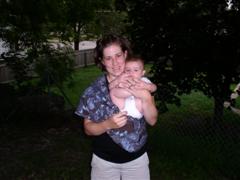 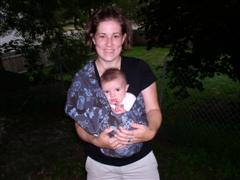
Wearing your baby on your hip/tummy to tummy:
Play Movie:
 Windows Media Windows Media
 Real Video Real Video
This is the position you will use for the longest period. Lower your
baby into the pouch with your baby's legs straddling your hip or
straight on facing you for the tummy to tummy. Your baby's butt should
rest on the inner edge of the pouch. Make sure the lower edge of
fabric is thoroughly covering baby's butt and thighs, with the lower
edge of binding in the crease of his knees. His calves and feet will
be sticking out of the bottom of the pouch. Then pull the upper edge
of fabric/binding up his back and under his arms. Some babies like the
fabric pulled over their shoulders-this works well for discrete
nursing. In order to keep pressure from the binding off of your baby's
legs, please ensure that your baby's butt is being worn several inches
below the crook of his knees. It also helps to "fold" the sling back
down over your shoulder. This helps keep the top rail tight and secure
around your baby (see picture). The only difference between the tummy
to tummy and the hip carry is the position of the baby on you.
 
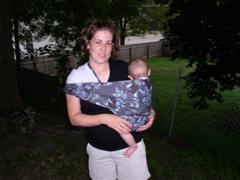
Wearing your baby on your back:
Play Movie:
 Windows Media Windows Media
 Real Video Real Video
Once your baby is securely in the hip position (see above), you may
slide the pouch and baby around to your back while you bend over. I
kind of bounce it around to the back. I get the baby far on my hip and
then slide them behind my arm. Pull the top rail of the sling up
around the baby's back to make the secure. Older children may want
their arms out. I always keep them on one side of my back and get the
back the same way. Slide them back till I can reach and bring them
forward.

Other Notes:
Breastfeeding:
Nursing Horizontally: Place your baby in the sleeping/nursing
position, opposite of what you see in the cradle carry photo. The
baby's head will be where the feet are in the picture. This way the
head is lower, more closely aligned with your breast. Your baby will
probably need to stick his feet out of the pouch to accommodate his
length, as he/she grows. Ensure the lower edge of binding is wrapped
securely behind his knees with his butt lower than his legs. Nursing
vertically: Place your infant or toddler in the tummy to tummy
position. Your child will find it comfortable to bend his head forward
into the pouch to nurse as you help by tilting your breast upward.
Once baby is older, you can also nurse with baby on your hip.
Helpful Hints:
Once you get the baby into the position it helps to "bounce" them down
into the sling. Usually I just give a little tug on the outer edge. A
little bounce in your legs helps secure them down into the sling.
Folding the top rail of the sling back down over the outer edge of
your shoulder helps make the sling tight against the baby's back (see
back carry picture for a good example or hip carry).
Practice makes perfect…..I found that as I used the sling more and
more I got quicker and more efficient at getting the little one in and
out. I also found that just trying new ways to fold the sling back
over my shoulder made me more secure.
SAFETY:
Remember your little one is your responsibility. Some sling carries
work better with different ages and different physical capabilities.
Back carries have less supervision and therefore are often better with
an older child with head and back support.
|